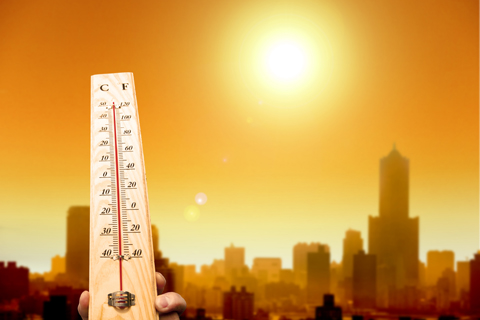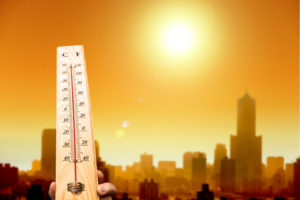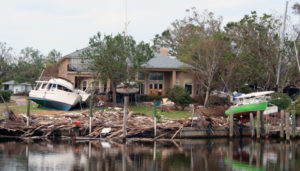
Extreme Temperatures: Not Dramatic, but Not Unimportant
 Extreme temperatures rarely result in big, national headlines. It isn’t as dramatic as the destructive earthquake. The toll taken on our country by temperature extremes isn’t often a matter of a single, crushing, attention-grabbing moment.
Extreme temperatures rarely result in big, national headlines. It isn’t as dramatic as the destructive earthquake. The toll taken on our country by temperature extremes isn’t often a matter of a single, crushing, attention-grabbing moment.
Extreme temperatures nonetheless present a pretty compelling level of danger when viewed in comparison to other disasters as shown through statistics.
The nation averaged an annual 569 heat-related deaths in the period from 1999 through 2005, according to the CDC.
It goes to show that disaster doesn’t always have to mean the big, attention-grabbing weather events such as tornadoes, earthquakes or regional flooding.
Extreme Temperatures: A “Compelling Level of Danger”
The extreme hot or cold weather events that strike many communities a few times every year might very well qualify as disasters on individual scales depending on the abilities of people to regulate their body temperatures.
Extreme temperatures nonetheless present a pretty compelling level of danger when viewed in comparison to other disasters as shown through statistics.
Figures on deaths directly attributed to individual, severe weather events show heat waves have been more deadly in the United States than tornadoes in recent decades.
From 1988 through 2011, stretches of excessive heat and humidity took an average of 146 lives per year.
Tornadoes, meanwhile, took an average of 76 lives during each of those years, according to National Weather Service statistics.
Heat waves took nearly triple the toll on human lives than hurricanes did when viewed from that broader 24-year average. It might be a mind-boggling statistic at the surface.
Memories, after all, tend to focus on events such as Hurricane Katrina or Superstorm Sandy. We lean on thoughts of all the devastation that reaches our homes through images on our computer and television screens.
Hurricanes, though, when viewed over that wide-view, 24-year scale brought an average of only 56 annual deaths, the NWS reports.
Extreme Heat: Nothing to Brush Off

Heat is a notable killer annually. Those living in or near Chicago wouldn’t need a reminder on the toll that extreme temperatures can take. A sweltering heat wave that struck the city in July 1995 caused more than 700 deaths. Temperatures rose in excess of 100 degrees in the Windy City and elsewhere in the Upper Midwest.
That stretch of heat was made all the more miserable by accompanying high humidity. More than 3,000 people in Chicago sought care in emergency rooms before the mercury on the thermometers began its merciful decline.
It was a crisis that might not have stuck to the country’s collective memory in the same vein as so many others have.
Heat waves, unlike hurricanes, aren’t given first names. For a point of comparison, Hurricane Ike in 2008 was among America’s most damaging in terms of property loss. Its irreplaceable toll was less so. It took 195 lives as it moved through the Caribbean,
into the Gulf of Mexico and onward into Louisiana and Texas.
That’s less than a third of Chicago’s 1995 losses from the all-important human standpoint.
That major heat wave, as well as its corresponding death toll, was far and away an anomaly. The human lives taken by heat in our country are more often spread thin across the summer months and among many different places.
It’s a danger that quietly comes to bear one death at a time. The prepper should take note. Those who don’t ay close attention could lose track of some fairly significant risks.
Statistics tell the bigger story. The United States, believe it or not, is occasionally fortunate to have some years pass by without a single death attributable to a hurricane.
There wasn’t a single hurricane-related death in either 2006 or 2010, according to the weather service. Only one died from a hurricane in 2007. There were only two throughout 2009.
Extreme Cold: Bundle Up
That simply isn’t the case when it comes to extreme temperatures. In 2011, 29 deaths were attributed to cold weather events in the United States, according to the weather service.
In 2010, 34 died from extreme cold events. In 2011, extreme temperatures took 206 lives. Extreme heat brought 138 fatalities across the country the year before.
Prepare for Extreme Temperatures as You Would Any Other Disaster
Extreme temperatures happen frequently enough. You fall to a severe disadvantage when either extreme is combined with an inability to escape. Shelter requires urgency.
It makes the very best sense to have plans to eliminate a pressing and dangerous threat. The big-time hazards that accompany inadequate shelter are ultimately preventable for those who do their homework.
From rolling blackouts to hurricanes, floods to tornadoes, power can go out at a moment's notice. If the grid fails, the PowerPot will keep you charging! The PowerPot thermoelectric generator converts any heat source directly into power that charges your USB handheld devices. Get Yours Now


![Best Concealed Carry Guns In 2025 [Field Tested] Wilson Combat EDC X9S 1](https://gundigest.com/wp-content/uploads/Wilson-Combat-EDC-X9S-1-324x160.jpg)


![Best 9mm Carbine: Affordable PCCs [Tested] Ruger Carbine Shooting](https://gundigest.com/wp-content/uploads/Ruger-Carbine-Shooting-100x70.jpg)
![Best AR-15: Top Options Available Today [Field Tested] Harrington and Richardson PSA XM177E2 feature](https://gundigest.com/wp-content/uploads/Harrington-and-Richardson-PSA-XM177E2-feature-100x70.jpg)
